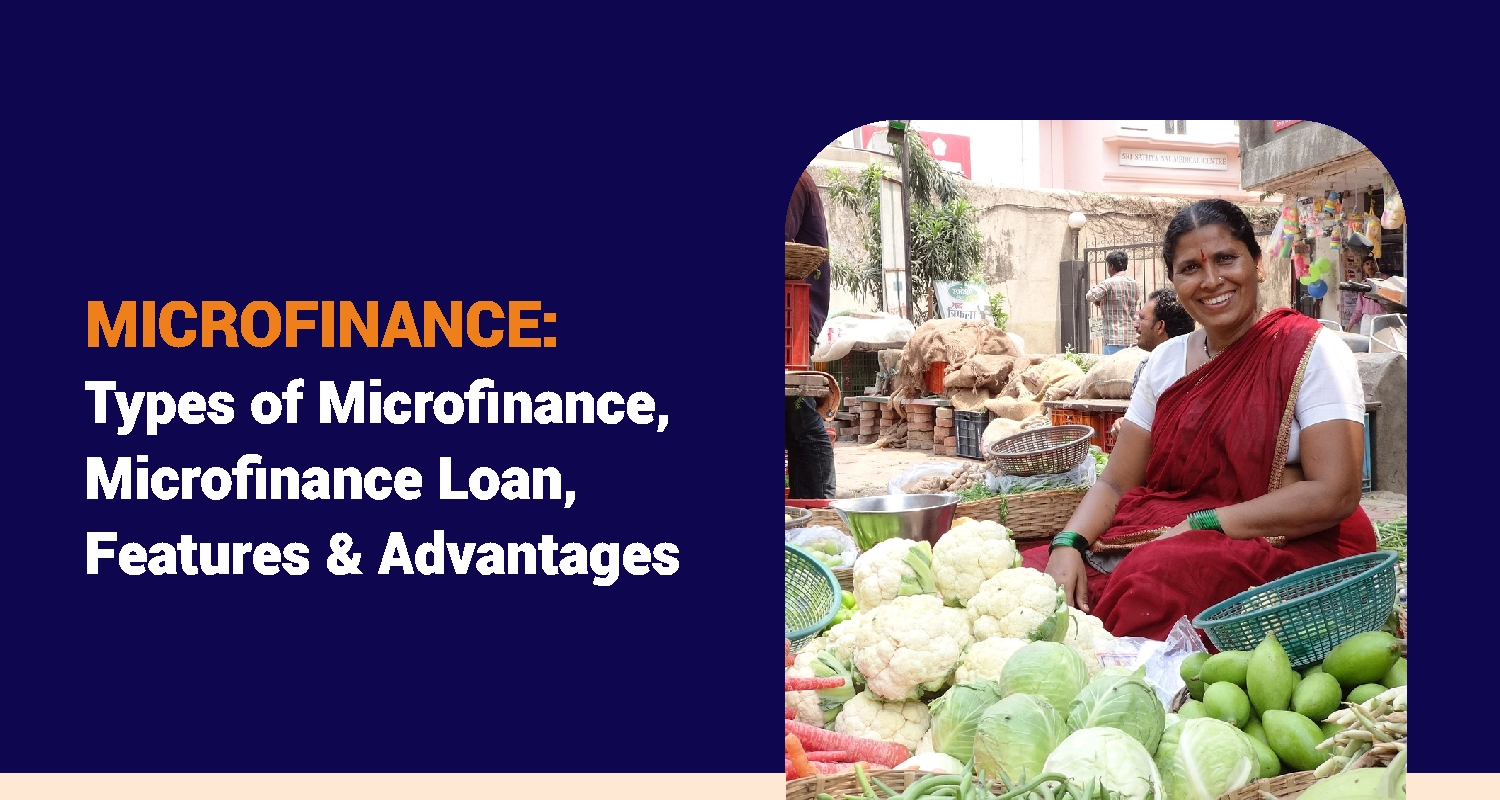Microfinance: Types, Loans, Features & Advantages

What is Microfinance?
Microfinance refers to a set of financial services designed for low-income individuals or those who lack access to traditional banking services. These services typically include micro-loans, savings, insurance, and remittances. The goal is to promote financial inclusion by offering these individuals a means to manage their income, build assets, and start small business.
Microfinance plays a key role in reducing poverty and promoting financial inclusion. If you want to know the answer to the question, "What is microfinance?" It refers to providing small loans to underserved communities, especially low-income individuals. Microfinance institutions (MFIs) help people start or expand businesses, improve their quality of life, and contribute to the economy.
Key Features of Microfinance:
- Small loan amounts: Microfinance loans are typically small, ranging from a few thousand to a few lakhs, making them accessible to those in need.
- Short-term loans: These loans often come with shorter repayment periods, which is beneficial for small businesses needing quick capital.
- Group lending: Microfinance institutions often encourage group lending, where individuals form groups and guarantee each other's loans, reducing the lender's risk.
- No collateral required: One of microfinance's defining features is that it doesn't require traditional forms of collateral.
- Focus on women: In India, a significant portion of microfinance services are directed toward women, empowering them to become economically independent.
Types of Microfinance
There are various types of microfinance, each serving different needs of the underprivileged. Below are the common forms of microfinance services, which will give you more insight into what is microfinance.
1. Microloans
Microloans are the most prominent form of microfinance. These loans are typically small and offered to individuals or small businesses that lack access to traditional credit services. The loans are often used to start a small business or expand existing ones, thereby helping the borrower improve their income and quality of life. These loans can range between Rs.10,000 to Rs.1,00,000 in India.
2. Micro Savings
Micro savings accounts allow individuals to save small amounts of money. These savings accounts do not have a minimum balance requirement, making them accessible to low-income individuals. They promote a habit of savings among those who traditionally do not have access to banking services.
3. Micro Insurance
Micro insurance provides low-income individuals with access to affordable insurance products. This could include life, health, and property insurance. The premiums for micro insurance policies are minimal, making them accessible to the poor.
4. Micro Credit
Micro credit is a broader term that includes loans but also extends to other financial services such as savings and insurance. It is aimed at providing financial services to those in poverty, enabling them to improve their financial situation.
5. Remittance Services
Many microfinance institutions also offer remittance services, helping individuals send or receive money across borders. This is particularly helpful for migrant workers who send money to their families in rural areas.
Microfinance Loans in India
Microfinance in India is largely facilitated through microloans, which have a significant impact on low-income groups, particularly in rural areas. These loans are usually given without collateral and are smaller in size. Microfinance loans enable individuals to start small businesses, send their children to school, and meet their basic financial needs.
To understand more about “what is microfinance” you should know that it involves providing small loans and financial services to individuals without access to conventional banking. In India, microfinance loans typically have a short tenure, usually 1 to 2 years. While the interest rates are higher than traditional bank loans, they are more affordable than informal moneylenders, contributing significantly to the economic empowerment and financial independence of lower-income communities.
Microfinance loans in India typically have a short tenure ranging between 1 to 2 years. The interest rates for these loans are generally higher than traditional bank loans, but lower than informal moneylenders. The availability of these loans has contributed to the economic empowerment of the lower-income strata of the population.
Sapna aapka. Business Loan Humara.
Apply NowCharacteristics of Microfinance
Understanding the characteristics of microfinance is essential to grasp what is microfinance, along with its purpose and benefits.
1. Targeting low-income households
Microfinance is aimed at individuals and households that are typically underserved by traditional banks. These households often lack formal financial records, making it difficult to access mainstream banking services.
2. No requirement for collateral
Most microfinance loans do not require collateral, which sets them apart from conventional loans. This makes microfinance accessible to individuals who lack assets to pledge as security.
3. Group Lending Model
Many microfinance institutions adopt a group lending model. Borrowers form small groups, and the entire group is collectively responsible for repaying the loan. This model not only reduces default rates but also fosters a sense of community among borrowers.
4. Focus on women empowerment
Microfinance has a significant focus on women, particularly in India. Research shows that women are more likely to invest in family welfare, education, and healthcare, leading to overall community upliftment.
5. Education and financial literacy
In addition to providing loans, microfinance institutions often offer financial literacy programs. These programs teach borrowers how to manage their income, savings, and credit, helping them make more informed financial decisions.
Objectives of Microfinance
The objectives of microfinance go beyond providing small loans. Here are the primary objectives, offering a clearer understanding of what is microfinance.
- Poverty Alleviation: Microfinance's main goal is to reduce poverty by giving low-income people access to financial services.
- Financial Inclusion: Microfinance aims to bring the unbanked population into the formal financial system.
- Entrepreneurship Promotion: By offering microloans, microfinance encourages entrepreneurship, enabling individuals to start and grow their businesses.
- Women Empowerment: Microfinance has a strong focus on empowering women, offering them financial independence and the ability to contribute to household income.
- Community Development: Microfinance aims to foster community development by improving the economic well-being of individuals, which in turn, benefits the community at large.
Advantages of Microfinance
The advantages of microfinance are numerous, especially when considering what is microfinance and its role in supporting individuals without access to traditional banking services. Below are some of the key benefits:
1. Promotes Financial Inclusion
Microfinance brings financial services to those who would otherwise be excluded from the formal banking sector. This includes individuals in rural and underserved areas who can now access savings, loans, and insurance.
2. Encourages Entrepreneurship
By providing access to small loans, microfinance encourages entrepreneurship and helps small businesses flourish. Many individuals use microloans to start or grow their businesses, leading to higher income levels and improved livelihoods.
3. Reduces Poverty
Microfinance is a proven tool for poverty reduction. By enabling individuals to invest in businesses, education, or healthcare, microfinance helps improve living standards and reduces poverty.
4. Empowers Women
In India, a significant portion of microfinance services is aimed at women. By offering them financial independence, microfinance contributes to women’s empowerment, allowing them to contribute to household income and make financial decisions.
5. Fosters Community Development
Microfinance loans often promote community development as successful entrepreneurs can provide employment and services to others in their local areas.
List of Microfinance Institutions in India
India has a vast network of microfinance institutions (MFIs) operating across the country. Below is a list of some prominent microfinance institutions in India:
- Bandhan Bank Bandhan Bank is one of the leading microfinance institutions in India, offering a range of financial services including microloans.
- SKS Microfinance Also known as Bharat Financial Inclusion Ltd., SKS Microfinance is a well-established MFI that provides microloans and other financial services.
- Spandana Sphoorty Financial Ltd. Spandana Sphoorty is one of the largest MFIs in India, providing financial services to underserved populations, particularly women.
- Ujjivan Financial Services Ujjivan focuses on providing financial services to the unbanked and underserved sectors of society, particularly in rural areas.
- Equitas Small Finance Bank Equitas offers microloans and savings accounts, and it has grown to become one of the prominent MFIs in India.
Conclusion
Microfinance is vital for increasing financial inclusion and reducing poverty in India. By providing services like small loans, savings, and insurance, microfinance institutions help people, especially women, improve their financial situations. Understanding “what is microfinance” reveals how these services positively impact the economy and the lives of millions. As India continues to grow, microfinance will remain an important tool for supporting low-income communities and boosting economic development.
Sapna aapka. Business Loan Humara.
Apply NowDisclaimer: The information contained in this post is for general information purposes only. IIFL Finance Limited (including its associates and affiliates) ("the Company") assumes no liability or responsibility for any errors or omissions in the contents of this post and under no circumstances shall the Company be liable for any damage, loss, injury or disappointment etc. suffered by any reader. All information in this post is provided "as is", with no guarantee of completeness, accuracy, timeliness or of the results etc. obtained from the use of this information, and without warranty of any kind, express or implied, including, but not limited to warranties of performance, merchantability and fitness for a particular purpose. Given the changing nature of laws, rules and regulations, there may be delays, omissions or inaccuracies in the information contained in this post. The information on this post is provided with the understanding that the Company is not herein engaged in rendering legal, accounting, tax, or other professional advice and services. As such, it should not be used as a substitute for consultation with professional accounting, tax, legal or other competent advisers. This post may contain views and opinions which are those of the authors and do not necessarily reflect the official policy or position of any other agency or organization. This post may also contain links to external websites that are not provided or maintained by or in any way affiliated with the Company and the Company does not guarantee the accuracy, relevance, timeliness, or completeness of any information on these external websites. Any/ all (Gold/ Personal/ Business) loan product specifications and information that maybe stated in this post are subject to change from time to time, readers are advised to reach out to the Company for current specifications of the said (Gold/ Personal/ Business) loan.



